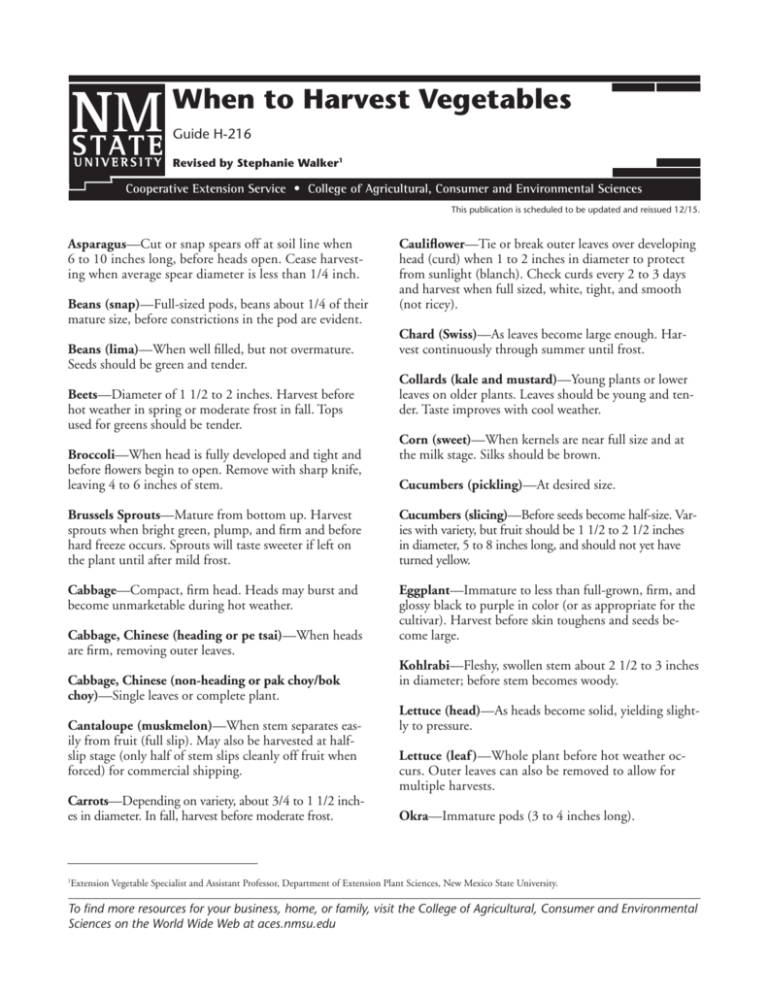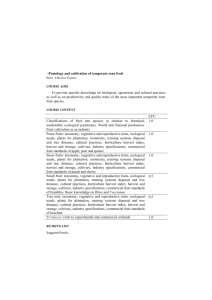
When to Harvest Vegetables
Guide H-216
Revised by Stephanie Walker1
Cooperative Extension Service • College of Agricultural, Consumer and Environmental Sciences
This publication is scheduled to be updated and reissued 12/15.
Asparagus—Cut or snap spears off at soil line when
6 to 10 inches long, before heads open. Cease harvesting when average spear diameter is less than 1/4 inch.
Beans (snap)—Full-sized pods, beans about 1/4 of their
mature size, before constrictions in the pod are evident.
Beans (lima)—When well filled, but not overmature.
Seeds should be green and tender.
Beets—Diameter of 1 1/2 to 2 inches. Harvest before
hot weather in spring or moderate frost in fall. Tops
used for greens should be tender.
Broccoli—When head is fully developed and tight and
before flowers begin to open. Remove with sharp knife,
leaving 4 to 6 inches of stem.
Cauliflower—Tie or break outer leaves over developing
head (curd) when 1 to 2 inches in diameter to protect
from sunlight (blanch). Check curds every 2 to 3 days
and harvest when full sized, white, tight, and smooth
(not ricey).
Chard (Swiss)—As leaves become large enough. Harvest continuously through summer until frost.
Collards (kale and mustard)—Young plants or lower
leaves on older plants. Leaves should be young and tender. Taste improves with cool weather.
Corn (sweet)—When kernels are near full size and at
the milk stage. Silks should be brown.
Cucumbers (pickling)—At desired size.
Brussels Sprouts—Mature from bottom up. Harvest
sprouts when bright green, plump, and firm and before
hard freeze occurs. Sprouts will taste sweeter if left on
the plant until after mild frost.
Cucumbers (slicing)—Before seeds become half-size. Varies with variety, but fruit should be 1 1/2 to 2 1/2 inches
in diameter, 5 to 8 inches long, and should not yet have
turned yellow.
Cabbage—Compact, firm head. Heads may burst and
become unmarketable during hot weather.
Eggplant—Immature to less than full-grown, firm, and
glossy black to purple in color (or as appropriate for the
cultivar). Harvest before skin toughens and seeds become large.
Cabbage, Chinese (heading or pe tsai)—When heads
are firm, removing outer leaves.
Cabbage, Chinese (non-heading or pak choy/bok
choy)—Single leaves or complete plant.
Cantaloupe (muskmelon)—When stem separates easily from fruit (full slip). May also be harvested at halfslip stage (only half of stem slips cleanly off fruit when
forced) for commercial shipping.
Carrots—Depending on variety, about 3/4 to 1 1/2 inches in diameter. In fall, harvest before moderate frost.
Kohlrabi—Fleshy, swollen stem about 2 1/2 to 3 inches
in diameter; before stem becomes woody.
Lettuce (head)—As heads become solid, yielding slightly to pressure.
Lettuce (leaf )—Whole plant before hot weather occurs. Outer leaves can also be removed to allow for
multiple harvests.
Okra—Immature pods (3 to 4 inches long).
Extension Vegetable Specialist and Assistant Professor, Department of Extension Plant Sciences, New Mexico State University.
1
To find more resources for your business, home, or family, visit the College of Agricultural, Consumer and Environmental
Sciences on the World Wide Web at aces.nmsu.edu
Onions (bulb)—Depending on variety, when about
half the tops have weakened and fallen over and bulbs
are at least 2 inches in diameter.
Onions (bunching)—Before bulbing starts or before
they become too thick (over 1/2 inch diameter).
Parsnips—Can be harvested any time they have attained a desired size. Taste improves after exposure to
several moderate freezes before being dug.
Peas (English)—Bright green, pods fully developed but
still tender, and before seeds develop fully. Peas should
be sweet when raw.
Peas (edible pod)—Harvest when pods fully developed,
but before seeds are more than half full size.
Peppers (bell, sweet)—Fruit should be full size but still
firm and crisp in texture. Harvest when green if green
fruits are desired. If sweeter, more mature fruits are desired, leave on plant until red, yellow, orange, or purple
color develops, according to variety.
Peppers (green chile)—Fruit should be full size, firm,
and crisp when squeezed. Harvest when fruit are green
or green with a slight amount of red color.
Peppers (red chile)—Fruit should be allowed to turn
completely red and left on plant until partially to fully
dried.
Potatoes (Irish)—Because tubers continue to grow
until vines die, they should not be harvested until vines
turn yellow or die. Tubers should be allowed to cure for
a few days in a well-ventilated, shady place. For new potatoes, harvest at any early stage of development.
Rhubarb—Delay harvest until second year after establishment. Established plantings (3 years) can be harvested for approximately 8 weeks. Harvest largest and
best stalks by grasping each stalk near base and pulling
slightly in one direction.
Spinach—Can be cut just below crown for once-over
harvest, or above the growing point to allow regrowth.
Older leaves can also be pinched off near the base of the
plant to allow multiple harvests.
Squash (summer)—As immature fruit when young and
tender. Fingernail should easily penetrate rind. Long-fruit
varieties (zucchini) are harvested when 6 to 8 inches long,
while scallops should be 3 to 4 inches in diameter.
Squash (winter)—Rind should be firm and glossy and
resist denting with a fingernail. Portion of fruit that
touches soil should be cream to orange in color when
mature. Harvest before a heavy frost.
Tomatoes—At the pink stage or beyond, but while fruit
is still firm.
Turnips—About 1 1/2 to 3 inches in diameter.
Watermelons—Tendril opposite fruit withers as fruit
ripens; soil spot (where watermelon rests on soil) turns
from white to creamy yellow; the rind at the soil spot
becomes tough and resists denting with a fingernail;
rapping or thumping produces a dull sound at maturity
rather than a hollow sound.
Original authors: J.N. Corgan, Agricultural Experiment Station, and Esteban Herrera, former Extension
Horticulture Specialist.
Potatoes (sweet)—Before freezing weather. Cure under
warm conditions (80–85°F) for a week.
Pumpkins—Fruit should be fully colored with skins
sufficiently hardened to resist denting with a fingernail.
Harvest before a hard freeze.
Radishes—As soon as roots reach edible size.
Stephanie Walker is Extension Vegetable Specialist, and has extensive experience in the food processing industry.
Her primary research interests include
genetics and breeding of chile peppers,
vegetable mechanization, enhancing pigment content, post-harvest quality, and
irrigation efficiency. She works to help
commercial vegetable growers enhance the
sustainability and profitability of their
operations through collaboration, experimentation, and information sharing.
Contents of publications may be freely reproduced for educational purposes. All other rights reserved. For permission to use
publications for other purposes, contact pubs@nmsu.edu or the authors listed on the publication.
New Mexico State University is an equal opportunity/affirmative action employer and educator. NMSU and the U.S. Department
of Agriculture cooperating.
Revised December 2010
Las Cruces, NM
Guide H-216 • Page 2










